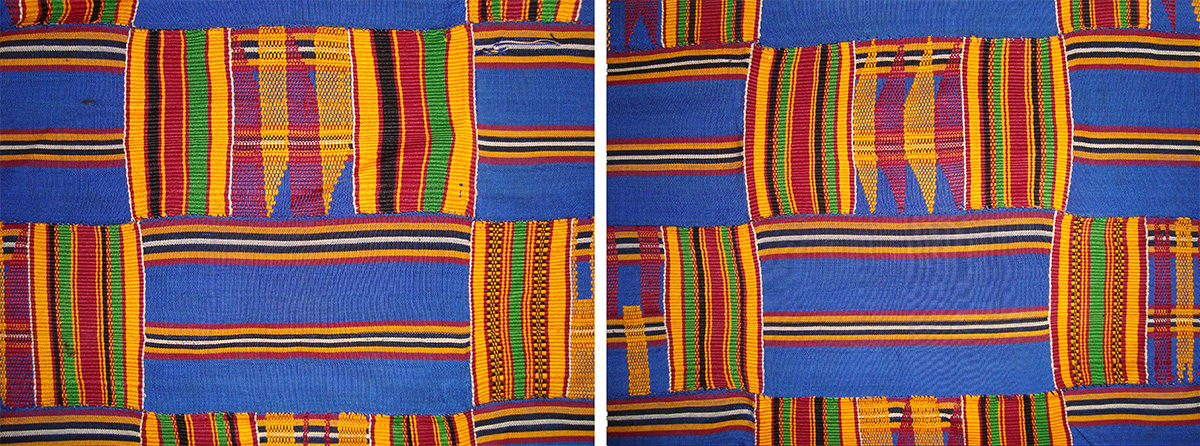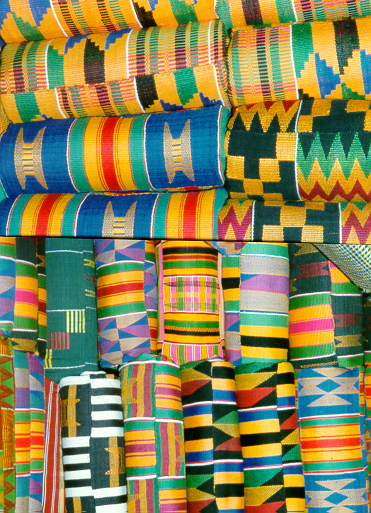Kente is one of Africa's most iconic cultural symbols, originating from the Ashanti people of Ghana but now recognized across the continent and beyond. This handwoven fabric carries significant historical, cultural, and social meaning, embodying African heritage through its vibrant colors, intricate patterns, and deep symbolism.
The Kente center of the world is the village of Bonwire, Ghana. AccordingtoAsantemythology, it was here that great trickster AnansetheSpider, ever skillful and cunning, spun a web of intricate detail in the jungle. When Nana Koragu and Nana Ameyaw, brothers and weavers by trade, came upon Ananse’s web, its immaculate beauty enchanted them. After studying Anansi’s handiwork, the pair returned to the village and began to weave Kente.
Kente fabric textile production among the Akan and Ewe peoples began as early as 1000 B.C. Kente cloth as we know it today with its rich bold colors emerged among the Asante during the seventeenth century A.D., as Chief Oti Akenten (from whose name Kente derives – “basket” in Twi) established trade routes from the Middle and Far East bringing into the Asante Empire a variety of foodstuffs, gems, dyes, leather goods, and silk fabric. Chief Akenten commissioned the new cloth to be spun for royal ritual attire. Men traditionally wear Kente wrapped over their shoulders in the style of a Roman toga while women wear it in two pieces, an ankle-length dress and a shawl that could double as a baby sling.Kente is a meaningfulsartorialdevice, as every aspect of its aesthetic design is intended as communication. The colors  of the cloth each hold symbolism: gold = status/serenity, yellow = fertility, green = renewal, blue = pure spirit/harmony, red = passion, black = union with ancestors/spiritual awareness. Kente cloth sheets are assembled out of sewing together long strips or bands of fabric, each 6”-10” wide. Each one of these bands are themselves composed of panels of alternating designs. Each weaver creates this patchwork appearance through a complex interplay of the warp (the threads pulled left to right during weaving) and weft (threads oriented up and down).
of the cloth each hold symbolism: gold = status/serenity, yellow = fertility, green = renewal, blue = pure spirit/harmony, red = passion, black = union with ancestors/spiritual awareness. Kente cloth sheets are assembled out of sewing together long strips or bands of fabric, each 6”-10” wide. Each one of these bands are themselves composed of panels of alternating designs. Each weaver creates this patchwork appearance through a complex interplay of the warp (the threads pulled left to right during weaving) and weft (threads oriented up and down).
These warp and weft motifs form a repertoire of craft work, as Asante weavers give each one a name that indicates clan, social status, or sexuality, such as AberewaBene meaning “a wise old man symbolized wisdom and maturity.” Other Kente design names form proverbs reflecting the Asante ethos and worldview. Owu nhye da (“Death has no fixed date”) is said to encourage people to right living, as death may come unexpectedly and allow no time for penitence. Nkum me fie na nkosu me aboten (“Don’t kill my house and then mourn for me in public”) cautions against the two-faced and duplicitous impulse of human nature. Richly expressive and personalized Kente meanings emerge out of clever combinations of colors with various warp and weft designs. Kente cloth materialized the spoken rhetoric of proverbs and circulated them among the Asante as sartorial text/iles.
1. Origins and Historical Significance
Kente weaving is believed to have originated from the Ashanti Kingdom in present-day Ghana during the 17th century. The tradition of weaving was inspired by observing a spider weaving its web, leading to the intricate and symbolic patterns that characterize kente.
The origins of Kente cloth date back to 12th century Africa, in the country of Ghana and the Ashanti people. The cloth was worn by Kings, Queens, and important figures of state in Ghana's society during ceremonial events and special occasions.
Each Ashanti king would create a new Kente design after close consultation with master weavers during his reign. This new Kente design had to be chosen with great care because its pattern and symbolic meaning would always be associated with this particular king.
The Kente cloth received its name from the term "kenten," which means "basket," because of the cloth's woven design. Each Kente pattern was unique and had its own name.
Weavers used vibrant colors and complex designs to portray the cloth's profound philosophical meaning. Kente cloths came to represent the history, philosophy, ethics, and moral values of Ghanaian cultural 
Initially, kente was exclusively worn by royalty, chiefs, and people of high status, reserved for special occasions such as festivals, ceremonies, and important social events. Over time, it became more accessible to others while still retaining its cultural significance.
2. Cultural Symbolism
Colors and Patterns: Each kente cloth is rich in meaning, with specific colors and patterns representing different ideas, values, or historical events. For example:
Gold symbolizes royalty, wealth, and spiritual purity.
Green represents growth, fertility, and renewal.
Black signifies strength, unity, and maturity.
Blue stands for peace, love, and harmony.
The patterns, known as "Adwinasa" or motifs, can also convey messages, such as proverbs, stories, or social status. Some patterns are named after famous individuals, events, or philosophical concepts, reflecting the deep cultural and historical context woven into each piece.
3. Traditional Uses and Social Functions
Kente is prominently worn during significant life events like weddings, funerals, naming ceremonies, and festivals such as "Akwasidae" and "Homowo." Its use often marks important rites of passage or celebratory occasions.
It is also used in chieftaincy and royal settings, where different styles or patterns may indicate a chief’s rank, authority, or role within the community.
In some regions, specific kente patterns are used for mourning or commemorating ancestors, reflecting respect and remembrance.
4. Modern Adaptations and Global Influence
Kente has transcended its traditional roots and become a symbol of African identity and pride worldwide. It is now used in fashion, art, and even academic regalia (graduation stoles), symbolizing connection to African heritage.
Designers and artists incorporate kente-inspired patterns into modern clothing, accessories, and home décor, making it accessible to a global audience while preserving its cultural essence.
During events like Black History Month, kente is used as a representation of African heritage and cultural pride in the African diaspora.
5. Economic and Cultural Preservation
The production of kente supports local economies in Ghana, especially in towns like Bonwire, Adanwomase, and Agotime, which are known for their weaving traditions. Artisans and weavers pass down their skills through generations, helping preserve the cultural practice.
Efforts to protect the authenticity and intellectual property of kente are ongoing, as imitation fabrics are often mass-produced without acknowledging the cultural context. Promoting authentic kente helps ensure that the traditional craftsmanship is valued and sustained.
6. Cultural Symbol in the Diaspora
In the African diaspora, kente serves as a powerful symbol of cultural identity, resistance, and unity. It is often worn during events celebrating African heritage, including cultural festivals, graduations, and political movements.
During significant moments in history, such as the civil rights movement and modern social justice campaigns, kente cloth has been used to symbolize solidarity and a connection to African roots.
Kente is not merely a fabric; it is a cultural emblem that tells stories, conveys values, and reflects the history and identity of the people who wear and weave it. Its patterns and colors carry centuries of tradition, making it a living representation of African heritage.

 of the cloth each hold symbolism: gold = status/serenity, yellow = fertility, green = renewal, blue = pure spirit/harmony, red = passion, black = union with ancestors/spiritual awareness. Kente cloth sheets are assembled out of sewing together long strips or bands of fabric, each 6”-10” wide. Each one of these bands are themselves composed of panels of alternating designs. Each weaver creates this patchwork appearance through a complex interplay of the warp (the threads pulled left to right during weaving) and weft (threads oriented up and down).
of the cloth each hold symbolism: gold = status/serenity, yellow = fertility, green = renewal, blue = pure spirit/harmony, red = passion, black = union with ancestors/spiritual awareness. Kente cloth sheets are assembled out of sewing together long strips or bands of fabric, each 6”-10” wide. Each one of these bands are themselves composed of panels of alternating designs. Each weaver creates this patchwork appearance through a complex interplay of the warp (the threads pulled left to right during weaving) and weft (threads oriented up and down). 




